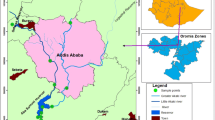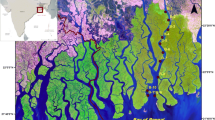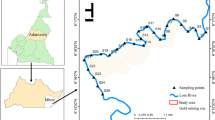Abstract
The distribution of trace metals (spatial and temporal) and sedimentary fractions were investigated to identify the concentrations and sources of trace metals within Kogarah Bay, NSW, Australia. A total of 59 surface sediments and six subsurface samples from core of the sediment were collected. The contamination factor and pollution load index indices used to evaluate environmental effects of trace metals. The study area was found to be uncontaminated with Cr and Ni, moderately contaminated with As and considerably contaminated with Cu, Zn and Pb. The concentrations of Cr and Ni were below both effect range low and effect range median, while As, Cu, Zn and Pb were slightly above effect range low. The highest concentrations of these trace metals such as Cu, Zn and Pb were found in the north, northwest and southeast of the bay, close to discharge points, stormwater outlets and around boatyards and watercrafts. The spatial distributions of metals were strongly related to muddy particles and organic matter. The temporal sediments of metals declined with increased sediment depth, which reflects accumulation of trace metals since European settlement in this area. Furthermore, the source of the trace metals was found to be stormwater outlets, gasoline fumes, boatyards and other human activities.







Similar content being viewed by others
References
Bakan, G., & Özkoç, H. B. (2007). An ecological risk assessment of the impact of heavy metals in surface sediments on biota from the mid-Black Sea coast of Turkey. International Journal of Environmental Studies, 64, 45–57.
Birch, G. F., & Taylor, S. E. (1999). Source of heavy metals in sediments of the Port Jackson estuary, Australia. Science of the Total Environment, 227, 123–138.
Chen, C., Zheng, B., Jiang, X., Zhao, Z., Zhan, Y., Yi, F., & Ren, J. (2013). Spatial distribution and pollution assessment of mercury in sediments of Lake Taihu, China. Journal of Environmental Sciences, 25, 316–325.
El-Said, G. F., & Youssef, D. H. (2013). Exotoxicological impact assessment of some heavy metals and their distribution in some fractions of mangrove sediments from Red Sea, Egypt. Environmental Monitoring and Assessment, 185, 393–404.
Fernandes, L., Nayak, G. N., Ilangovan, D., & Borole, D. V. (2011). Accumulation of sediment, organic matter and trace metals with space and time, in a creek along Mumbai coast, India. Estuarine, Coastal and Shelf Science, 91, 388–399.
Hakanson, L. (1980). An ecological risk index for aquatic pollution control: a sedimentological approach. Water Research, 14, 975–1001.
Hamer, K., & Karius, V. (2002). Brick production with dredged harbour sediments. An industrial-scale experiment. Waste Management, 22, 521–530.
Harikumar, P. S., Nasir, U. P., & Rahman, M. P. (2009). Distribution of heavy metals in the core sediments of a tropical wetland system. International Journal of Environmental Science and Technology, 6, 225–232.
Irvine, I., & Birch, G. F. (1998). Distribution of heavy metals in surficial sediments of Port Jackson, Sydney, New South Wales. Australian Journal of Earth Sciences, 45, 297–304.
Johnston, C. P., & Chrysochoou, M. (2014). Mechanisms of chromate adsorption on hematite. Geochimica et Cosmochimica Acta, 138, 146–157.
Jones, B. G., Killian, H. E., Chenhall, B. E., & Sloss, C. R. (2003). Anthropogenic effects in a coastal lagoon: geochemical characterization of Burrill Lake, NSW, Australia. Journal of Coastal Research, 19, 621–632.
Kogarah Council (2014). Population, Personal communication.
Li, J., & Heap, A. D. (2008). A Review of Spatial Interpolation Methods for Environmental Scientists. Geoscience Australia, 137pp.
Ligero, R. A., Barrera, M., Casas-Ruiz, M., Sales, D., & López-Aguayo, F. (2002). Dating of marine sediments and time evolution of heavy metal concentrations in the Bay of Cádiz, Spain. Environmental Pollution, 118, 97–108.
Liu, Z., Shao, M., & Wang, Y. (2013). Spatial patterns of soil total nitrogen and soil total phosphours across the entire Loess Plateau region of China. Geoderma, 197, 67–78.
McLean, E., McPherson, B. L., & Hinwood, J. B. (2002). A Decision Support Tool for Prioritising Remediation Works in a Catchment/Estuarine Bay System Conference Proceedings of Integrative Modelling of Biophysical, Social, and Economic Systems for Resource Management Solutions: Proceedings of the International Congress on Modelling and Simulation, Monash University. 548–553.
Mendiguchía, C., Moreno, C., Mánuel-Vez, M. P., & García-Vargas, M. (2006). Preliminary investigation on the enrichment of heavy metals in marine sediments originated from intensive aquaculture effluents. Aquaculture, 254, 317–325.
Norrish, K., & Chappell, B. (1977). X-ray fluorescence spectrometry. In J. Zussman (Ed.), Physical methods in determinative mineralogy (pp. 201–272). London: Academic Press London.
Pekey, H. (2006). Heavy metal pollution assessment in sediments of the Izmit Bay, Turkey. Environmental Monitoring and Assessment, 123, 219–231.
Pekey, H., Karakas, D., Ayberk, S., Tolun, L., & Bakoglu, M. (2004). Ecological risk assessment using trace elements from surface sediments of Izmit Bay (northeastern Marmara Sea) Turkey. Marine Pollution Bulletin, 48, 946–953.
Qiu, Y.-W., Lin, D., Liu, J.-Q., & Zeng, E. Y. (2011). Bioaccumulation of trace metals in farmed fish from South China and potential risk assessment. Ecotoxicology and Environmental Safety, 74, 284–293.
Reboredo, F. (1993). How differences inthe field influence Cu, Fe and Zn uptake by Halimione-portulacoides and Spartina maritima. The Science of the Total Environment, 133, 111–132.
Romero, A., González, I., Fernández, I. M., & Galán, E. (2013). Evaluation of trace element contamination changes in soils using a new normalization factor: application to the guadiamar soils (SW Spain) affected by a mine spill in 1998. Journal of Geochemical Exploration, 124, 29–39.
Ruiz, F., Abad, M., Galán, E., González, I., Aguilá, I., Olías, M., Ariza, J. L. G., & Cantano, M. (2006). The present environmental scenario of El Melah Lagoon (NE Tunisia) and its evolution to a future sabkha. Journal of African Earth Sciences, 44, 289–302.
Spijker, J., Vriend, S. P., & van Gaans, P. F. M. (2005). Natural and anthropogenic patterns of covariance and spatial variability of minor and trace elements in agricultural topsoil. Geoderma, 127, 24–35.
Tomlinson, D. L., Wilson, J. G., Harris, C. R., & Jeffrey, D. W. (1980). Problems in the assessment of heavy-metal levels in estuaries and the formation of a pollution index. Helgoländer Meeresuntersuchungen, 33, 566–575.
Xu, G., Liu, J., Pei, S., Kong, X., & Hu, G. (2014). Distribution and source of heavy metals in the surface sediments from the near-shore area, north Jiangsu Province, China. Marine Pollution Bulletin, 83, 275–281.
Yang, Y., Chen, F., Zhang, L., Liu, J., Wu, S., & Kang, M. (2012). Comprehensive assessment of heavy metal contamination in sediment of the Pearl River Estuary and adjacent shelf. Marine Pollution Bulletin, 64, 1947–1955.
Zhang, W., Zhao, D., & Wang, X. (2013). Agglomerative clustering via maximum incremental path integral. Pattern Recognition, 46, 3056–3065.
Zhao, H., Xia, B., Fan, C., Zhao, P., & Shen, S. (2012). Human health risk from soil heavy metal contamination under different land uses near Dabaoshan Mine, Southern China. Science of the Total Environment, 417–418, 45–54.
Zhao, L., Xu, Y., Hou, H., Shangguan, Y., & Li, F. (2014). Source identification and health risk assessment of metals in urban soils around the Tanggu chemical industrial district, Tianjin, China. Science of the Total Environment, 468–469, 654–662.
Zoumis, T., Schmidt, A., Grigorova, L., & Calmano, W. (2001). Contaminants in sediments: remobilisation and demobilisation. Science of the Total Environment, 266, 195–202.
Acknowledgements
This paper is a part of author Ph.D. thesis undertaken at the School of Earth and Environmental Sciences, University of Wollongong. It was financially supported by the Ministry of Higher Education and Scientific Research, Iraqi Government and GeoQuest Research Centre, University of Wollongong, Australia.
Author information
Authors and Affiliations
Corresponding author
Rights and permissions
About this article
Cite this article
Alyazichi, Y.M., Jones, B.G. & McLean, E. Source identification and assessment of sediment contamination of trace metals in Kogarah Bay, NSW, Australia. Environ Monit Assess 187, 20 (2015). https://doi.org/10.1007/s10661-014-4238-z
Received:
Accepted:
Published:
DOI: https://doi.org/10.1007/s10661-014-4238-z




